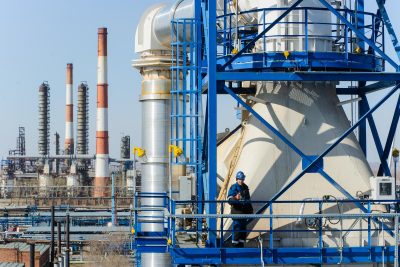The production of gasoline begins with desalting the viscous crude oil. Salts and metals in the crude oil promote corrosion and poison processing catalysts. Thus, the crude oil is heated (to decrease viscosity) and extracted with water to remove the salts and metals. Frequently this process results in the formation of an oil/water mixture referred to as an emulsion (suspension). This emulsion is typically broken by the addition of a chemical surfactant (demulsifier) that promotes the separation of discrete oil and water layers. After separation of the aqueous layer, the oil is heated to about 400 o C (752 o F): This converts the oil into gaseous products and increases the fluidity of the remaining liquid. In this form, the gaseous mixture enters the fractionating column, where the process of atmospheric fractional distillation separates the crude oil into different components based upon boiling point.
The lightest boiling fractions are molecules that are gases under ambient conditions: methane, ethane, propane, butane, and olefins derived from these compounds. Uses for this distillate stream include burning as a fuel at the refinery; as petrochemical feed stocks; or processing into liquefied petroleum gas (LPG). There are three other major distillate streams collected during atmospheric distillation: the naptha fraction, which has a boiling range of 30 to 180°C (86–356°F); the kerosene fraction, which distills at between 180 and 240°C (356–464°F); and the gas oil fraction, which distills at between 240 and 355°C (464–671°F).
In order to meet current environmental regulations for the sulfur content in fuel products, the three-distillate streams are subjected to the process of hydrodesulfurization. In the presence of a catalyst , distillates are heated in the presence of hydrogen to reduce various organosulfur compounds to simple organic compounds and H 2 S. The hydrogen needed for this process is a by-product of the catalytic reforming process. The H 2 S product can be readily removed. In this process the refiner can control the octane number of the gasoline blending stock. By heating the naphtha fraction in the presence of an especially designed platinum catalyst, straight-chain hydrocarbons are cyclized, and saturated cyclic hydrocarbons are converted into aromatic compounds. In addition, this process converts straight-chain hydrocarbons into branched hydrocarbons. Catalytic reforming facilitates the production of gasoline blending stocks with octane ratings of from 90 to 100+.
Redistilling the atmospheric residue at a temperature of less than 400°C (752°F) under vacuum produces a vacuum gas oil. Typically, the vacuum gas oil is subjected to fluid catalytic cracking (FCC) to produce lower-boiling liquids that can be blended to make gasoline. This is achieved by breaking large molecules of the vacuum gas oil into smaller, lower-boiling molecules. An important gasoline blending component that can be produced in this manner is alkylate. It is a mixture of highly branched hydrocarbons produced by the acid-catalyzed reaction of isobutene and light olefinic hydrocarbons. Alkylate is a valuable blending component because of its high-octane quality and the absence of aromatics or olefins, which can lead to environmental and oxidative stability problems.
The 1990 Clean Air Act required the Environmental Protection Agency (EPA) to issue regulations that required gasoline to be “reformulated,” resulting in significant reductions in vehicle emissions of ozone-forming and toxic air pollutants. This cleaner gasoline is called reformulated gasoline (RFG). RFG is required in the nine major metropolitan areas in the United States having the worst ozone problems. In addition, several other areas with ozone levels exceeding the public health standard have voluntarily chosen to use RFG.
Use of RFG decreases the amounts of volatile organic compounds (VOCs) and oxides of nitrogen (NO x ) in the atmosphere that react in the presence of sunlight to produce ozone, a major component of smog. Vehicles also release toxic emissions, one of which (benzene) is a known carcinogen.
RFG contains 2 percent by weight oxygen additives (oxygenates), such as MTBE or ethanol. Oxygenates increase the combustion efficiency of gasoline, reducing vehicle emissions of carbon monoxide, a serious public health threat. The appearance of MTBE in some urban water supplies has resulted in legislation pending in the U.S. Congress to phase out the use of MTBE in RFG. Ethanol would then most likely become the primary oxygenate for future RFG.
Gasoline is the most important product of the oil refinery. The most important quality parameter for gasoline is its octane number. Additional quality characteristics for gasoline are controlled by the use of additives, for example, antioxidants, metal deactivators, and detergents. By blending various refinery streams and additives a gasoline formulation can be achieved that minimizes environmental degradation. Such a fuel is called reformulated gasoline.







